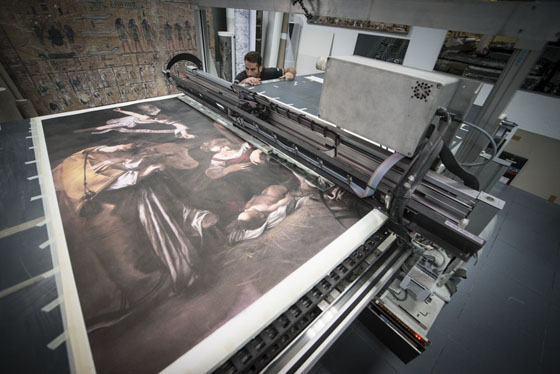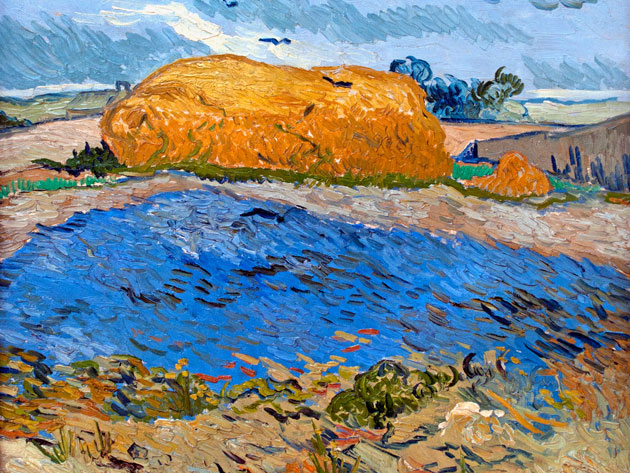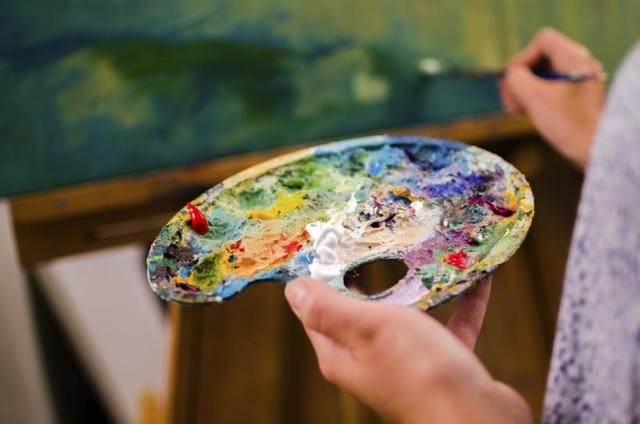Label: art history
Wednesday 30th November 2016Truth, Lies, and Art Preservation
We recently wrote an edition of Artist Spotlight that featured the work of a young boy hoping to recreate the lost works of his cultural heritage as a means of fighting back against the devastation caused by the fanatics of the Islamic State. It was a touching story, and one that brings hope to the fight against the IS, but today we're going to look at a much more industrialized version of that struggle.
Welcome to Factum. This is a cutting-edge (literally, excuse the pun) factory that provides a number of artistic services, including working with big-name sculptors such as Anish Kapoor Maya Lin and Marc Quinn to realize their visions when the technical requirements are outside the artist's native capabilities.
That's not all they do, however- they also reconstruct pieces of cultural history that were destroyed by various terrorist groups or in other types of disaster.
They are incredibly talented, and incredibly perfectionist about it. The man in charge of Factum's replication services is Adam Lowe, and recently he went to see another firm's replica of a sculpted marble arch that was destroyed in Palmyra, Syria, also by the Islamic State terrorists.
Speaking to the New Yorker, he explained his distate: “If you look at the arch, there are these beautiful Corinthian columns on it, and on the finial it looks like there’s an artichoke on it. You can just tell that one of the people making it was, like, ‘That’s too hard right there,’ and simplified the shape! It’s appalling.”
As the author of the New Yorker piece opines, many people would first recall Walter Benjamin and the value (or lack thereof) in a replicated object - but can that really hold true when the original no longer exists? Perhaps there is a new 'aura' constructed around this object, even if it tempered by the knowledge that it isn't hundreds or thousands of years old.
Lowe, however unsurprisingly, disagrees again. "Factum is a place of atemporal creativity. People always say, ‘Isn’t it difficult working with contemporary artists and working with, say, Caravaggio?’ The answer is no. They’re exactly the same. The only difference is that Caravaggio is dead.”
Hopefully, they will be able to use incredibly sophisticated computer modelling technology to reconstruct objects from images, even when the original has long since been destroyed. Too much of the world's beautiful objects have been lost over the years, whether to willful destruction, simple negligence, or pure chance. The prospect of having them back with us is a wonderful one to envision.
Posted on November 30th 2016 on 02:31am
0 Comments
Tuesday 30th June 2015Van Gogh and Art Preservation
It seems strange to say, but we almost take it for granted that the artworks of the ancient masters are immutable. Certainly, they are subject to the rigours and stresses of time, but usually this presents itself of the form of craquelure (the name given to the intricate network of cracks and splits that occur in oil paintings, most commonly visible in works of the European old masters), slight fading, or something similar that tends to reinforce the sense of gravity and aura that surround the actual paintings themselves. What we don't expect is for the actual pigments themselves to change, beyond natural aging.
This turns out to be exactly what's happening to one of Vincent Van Gogh's masterpieces, entitled 'Wheat Stack Under A Cloudy Sky'. The red pigments Van Gogh used extensively in his work, known as 'red lead' or 'r minium', have been slowly fading away to white, rather than simply losing their lustre and vibrancy as might be expected in the normal aging of paint. Thanks to some new investigative work by researchers at the University of Antwerp using a new X-ray powder diffraction mapping and tomography techniques, they were able to dig down into the cause of the pigmentation shift.
In Chemistry World, Matthew Gunther said "Researchers think that when red lead is exposed to light it is converted into plumbonacrite, which reacts with carbon dioxide to form hydrocerussite and cerussite." For those of us who don't have an advanced chemistry degree (probably most of us ;-) ) that the chemicals used in the pigment are interacting with the carbon dioxide in the air and changing their chemical properties, which in turn changes the pigment towards white.
Alison Meier, an art writer and theorist, speaking about the importance of this finding, said that "continued research on the chemistry of van Gogh's pigments could have a wider influence on art conservation. And importantly, it could influence the way his paintings are displayed in light, knowing that the rare mineral in the red may fade from the colors the artist originally envisioned."
It really starts to raise questions about how long these original masterpieces can be expected to stay true to the original vision of the artist, and how best to preserve them for future generations. While it's a beautiful image to see in a digital reproduction, it's still not quite the same as seeing the original work in all its glory. Hopefully, these discoveries will also shed some light on possible practices for art conservation and preservation, as science and technology advance into uncharted territory.
Posted on June 30th 2015 on 04:03pm
0 Comments
Friday 12th June 2015The Hidden History of Art
Art is often mysterious. Anyone who has been spellbound by portraits and still lifes from long ages past or gotten lost in the exploration of a mirror-world of meanings behind conceptual artwork will be familiar with this. The primary difference is that conceptual artwork tends to be the subject of lively modern debate, whereas works by artists long centuries dead are inherently more mysterious, as there are naturally none living today to who were alive at the same time as the artist. It thus falls to the art historian, anthropologists and other experts to make best guesses at the stories behind the development of some of the most famous works of art.
Recently these artistic excavators got a new tool in their arsenal, courtesy of a new advanced scanning technique being developed by a group called INSIDDE - "INtegration of technological Solutions for Imaging, Detection, and Digitisation of hidden Elements in artworks" - pretty long winded, but they're doing some great work. Typically, x-ray and infrared reflectography is used to peer inside paintings, but this is largely avoided unless absolutely necessary, as these techniques heat the materials of the painting, which can lead to cracking or other types of erosion, and in some cases seriously damaging the work.
Thanks to recent developments in terahertz scanning, this problem has been avoided. Terahertz scanning has been generally unreliable for extremely fine detail work, like that necessary in the art world, but new developments in material science has provided a way past these stumbling blocks. Incorporating the space-age nanomaterial graphene, the researchers were able to generate a terahertz scanner that overcame this problem and has allowed them to look at each and every single layer of material created by the artist, included individual layers of gesso.
The project is still in the prototyping phase, but promises to be an exciting new tool for art historians and researchers. Who knows what hidden details lurk beneath the surface of some of the greatest masterpieces in the world? Thanks to this revolutionary new method, we may soon be able to find out - let's just hope it doesn't turn into some real life Da Vinci Code. Although, on second thought, that might actually be even more incredibly amazing. Only time will tell for sure, but we can expect some interesting results in the next couple of years!
Posted on June 12th 2015 on 05:02pm
0 Comments
Friday 13th March 2015Genre Spotlight: Surrealism

We're going to be starting a new recurring series here at Gallereo, in a similar vein to our Artist Spotlight series, but taking a broader view and looking at artistic genres as a whole. Our hope is that we'll be able to give a bit of a bigger picture of the movements that lie behind and surround some of the world's most popular artists, and maybe even inspire some of you to experiment with new genres that you otherwise might have ignored! To that end, we start the series today with a quick look at Surrealism, that most whimsical and mystifying of all artistic genres.
First getting started in the 1920s in Europe, Surrealism originally had two opposing parties of artists who squabbled over the usage and priority of the term. These arguments got so heated that at one point, the leaders of the two factions, Andre Breton and Yvan Goll, actually got into a physical fight in the middle of the Champs Elysee in Paris, France. Breton's faction eventually proved the stronger, though history does not seem to relate who won the fistfight.
His unique definition of Surrealism also triumphed, as he describes it:
Dictionary: Surrealism, n. Pure psychic automatism, by which one proposes to express, either verbally, in writing, or by any other manner, the real functioning of thought. Dictation of thought in the absence of all control exercised by reason, outside of all aesthetic and moral preoccupation.
Encyclopedia: Surrealism. Philosophy. Surrealism is based on the belief in the superior reality of certain forms of previously neglected associations, in the omnipotence of dream, in the disinterested play of thought. It tends to ruin once and for all other psychic mechanisms and to substitute itself for them in solving all the principal problems of life.
Some of the most famous Surrealist artists are household names, now viewed with reverence: Salvador Dali, Max Ernst, Man Ray, Rene Magritte and Joan Miro, not to mention Andre Breton himself, are names that every art student has run across, and their popularity is still evident in university campuses around the world, who regularly feature shows, film festivals, and other celebrations of the Surrealist canon. Much of what we regard as postmodern has roots and themes that can be traced back to the Surrealist movement, and that leaves much of today's popular art an evolving legacy of the Surrealists.
Posted on March 13th 2015 on 01:01pm
0 Comments
 We recently wrote an edition of Artist Spotlight that featured the work of a young boy hoping to recreate the lost works of his cultural heritage as a means of fighting back against the devastation caused by the fanatics of the Islamic State. It was a touching story, and one that brings hope to the fight against the IS, but today we're going to look at a much more industrialized version of that struggle.
We recently wrote an edition of Artist Spotlight that featured the work of a young boy hoping to recreate the lost works of his cultural heritage as a means of fighting back against the devastation caused by the fanatics of the Islamic State. It was a touching story, and one that brings hope to the fight against the IS, but today we're going to look at a much more industrialized version of that struggle. It seems strange to say, but we almost take it for granted that the artworks of the ancient masters are immutable. Certainly, they are subject to the rigours and stresses of time, but usually this presents itself of the form of craquelure (the name given to the intricate network of cracks and splits that occur in oil paintings, most commonly visible in works of the European old masters), slight fading, or something similar that tends to reinforce the sense of gravity and aura that surround the actual paintings themselves. What we don't expect is for the actual pigments themselves to change, beyond natural aging.
It seems strange to say, but we almost take it for granted that the artworks of the ancient masters are immutable. Certainly, they are subject to the rigours and stresses of time, but usually this presents itself of the form of craquelure (the name given to the intricate network of cracks and splits that occur in oil paintings, most commonly visible in works of the European old masters), slight fading, or something similar that tends to reinforce the sense of gravity and aura that surround the actual paintings themselves. What we don't expect is for the actual pigments themselves to change, beyond natural aging. Art is often mysterious. Anyone who has been spellbound by portraits and still lifes from long ages past or gotten lost in the exploration of a mirror-world of meanings behind conceptual artwork will be familiar with this. The primary difference is that conceptual artwork tends to be the subject of lively modern debate, whereas works by artists long centuries dead are inherently more mysterious, as there are naturally none living today to who were alive at the same time as the artist. It thus falls to the art historian, anthropologists and other experts to make best guesses at the stories behind the development of some of the most famous works of art.
Art is often mysterious. Anyone who has been spellbound by portraits and still lifes from long ages past or gotten lost in the exploration of a mirror-world of meanings behind conceptual artwork will be familiar with this. The primary difference is that conceptual artwork tends to be the subject of lively modern debate, whereas works by artists long centuries dead are inherently more mysterious, as there are naturally none living today to who were alive at the same time as the artist. It thus falls to the art historian, anthropologists and other experts to make best guesses at the stories behind the development of some of the most famous works of art. We're going to be starting a new recurring series here at Gallereo, in a similar vein to our Artist Spotlight series, but taking a broader view and looking at artistic genres as a whole. Our hope is that we'll be able to give a bit of a bigger picture of the movements that lie behind and surround some of the world's most popular artists, and maybe even inspire some of you to experiment with new genres that you otherwise might have ignored! To that end, we start the series today with a quick look at Surrealism, that most whimsical and mystifying of all artistic genres.
We're going to be starting a new recurring series here at Gallereo, in a similar vein to our Artist Spotlight series, but taking a broader view and looking at artistic genres as a whole. Our hope is that we'll be able to give a bit of a bigger picture of the movements that lie behind and surround some of the world's most popular artists, and maybe even inspire some of you to experiment with new genres that you otherwise might have ignored! To that end, we start the series today with a quick look at Surrealism, that most whimsical and mystifying of all artistic genres.



